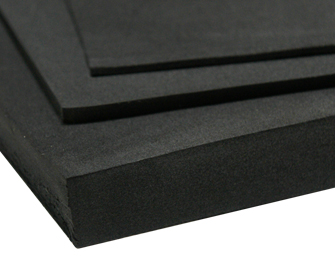|
|
An EPDM sheet is best known for its superior environmental resistance properties that make it the best outdoor rubber material. As an ozone resistant rubber, EPDM rubber parts are commonly found in outdoor settings. EPDM, vs neoprene, is commonly used in outdoor industrial applications not only due to its environmental resistance properties, but also due to its excellent strength, flexibility, and pliability. EPDM cellular rubber can also be used in outdoor settings without damage. Contrastingly, because it is an oil resistant rubber, neoprene rubber is generally used in applications that involve oils and greases. Although extremely resistant to chemicals, EPDM sheet rubber is best used outdoors and should not be used in oil and grease-related applications.
How Can You Tell Neoprene from EPDM?
You can tell neoprene from EPDM through the materials’ different physical and chemical properties. Neoprene and EPDM sheet rubber materials are both synthetic rubber variations, meaning they are man-made materials created with a blend of chemical compounds which give them their unique chemical and physical properties; however, because they are made with different chemical compounds, they will retain different properties. EPDM sheet rubber is made with a blend of ethylene, propylene, and diene monomers. The blend of these three monomers gives EPDM excellent resistance to damaging environmental factors found outdoors. Case in point, “EPDM elastomers have excellent heat, ozone/weathering, and aging resistance. They also exhibit excellent electrical insulation, compression set, and low temperature properties” (polymerdatabase.com). These properties make EPDM, vs neoprene, the ideal outdoor rubber that will provide long-lasting and reliable applications in any outdoor setting. On the other hand, neoprene rubber is made from the polymerization of chloroprene, a liquid chemical used almost exclusively to produce neoprene rubber (Wikipedia.org). The polymerization of chloroprene gives neoprene rubber material excellent resistance to chemicals, greases, and oils.
EPDM sheet material is commonly used in outdoor industrial settings due to its excellent chemical resistance properties as well as its superior environmental resistance properties. As an ozone resistant rubber, EPDM, vs neoprene, is a popular material used in the production of outdoor seals and gaskets. EPDM rubber parts can provide long-lasting and reliable outdoor rubber parts that will not deteriorate after extended exposure to UV rays, ozone, oxygen, and moisture. EPDM cellular rubber sheets are also available for highly compressive applications. EPDM cellular rubber is available in both open and closed cell EPDM sheets, allowing you to find the perfect density for your application. Closed cell EPDM, although a foam, is made of up tight-knit air pockets, making it dense enough to resist the permeation of moisture. EPDM sheet material, no matter solid or cellular, has a wide operating temperature range of -40 to +212 degrees Fahrenheit. Contrastingly, although it has moderate resistance to damaging environmental factors, neoprene rubber is generally used in oil or petroleum-related applications due to its resistance to oils and greases. Although EPDM retains excellent chemical resistance properties, it does not stand up well against oils and greases.

|

|
(a) Is EPDM Better Than Neoprene?
EPDM is not better than neoprene as both rubbers retains different properties that surpass that of the other rubber. An EPDM, vs neoprene is best known for being a durable ozone resistant rubber that is used in outdoor industrial applications whereas neoprene is best known for its resistance to oil and petroleum-derived solvents. Despite these differences in chemical resistance properties, as elastomers, both rubber materials retain a high tensile strength and low compression set, allowing them to provide protection against impacts and abrasions in industrial applications. Having a high tensile strength allows both EPDM and neoprene materials to resist tearing when stretched while having a low compression set allows them to provide ample cushioning against impacts. Overall, no one material is better than the other; an EPDM sheet and neoprene sheet are just used for separate applications.
EPDM sheet rubber is the superior outdoor rubber material that can resist degradation caused by harsh UV rays, ozone, oxygen, and moisture. EPDM, vs neoprene, is an extremely ozone resistant rubber that is commonly used in outdoor industrial applications. EPDM rubber parts, such as industrial seals and gaskets, will offer excellent protective properties against impacts and abrasions; however, unlike neoprene rubber, it is not compatible with oils and greases. EPDM cellular rubber also retains the same chemical and environmental resistance properties as solid EPDM. Because it is an ozone resistant rubber, closed cell EPDM can also be used in outdoor settings. EPDM sheet rubber is the superior outdoor material that can provide reliable protection against environmental factors, impacts, and abrasions. Is EPDM Better Than Neoprene?
|
|
|